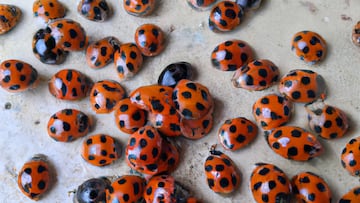Managing ladybug infestations: effective ways to remove ladybugs from your home
As swarms of the small beetles continue to take hold of properties around parts of the U.S. people are asking for help to get rid of them.


Ladybugs, also known as ladybirds in some regions, are generally regarded as harmless and even beneficial insects due to their role in controlling aphid populations in gardens. However, when these charming red or orange beetles decide to invade your home, they can quickly become a nuisance.
If you find yourself dealing with a ladybug infestation, fret not! There are several effective and humane ways to remove them from your house.
Stepped outside and got caught up in a ladybug swarm. pic.twitter.com/D8B3Lmd7fq
— Charles I. Groegler (@word777) October 24, 2023
How can I get rid of ladybugs?
Prevention is key
Although this is sometimes easier said than done, the best way to deal with ladybug infestations is to prevent them from happening in the first place. Seal all potential entry points, such as cracks, gaps, and holes in doors, windows, and walls. Ensure your screens are in good condition and fit snugly. Weather stripping can be used to reinforce door and window seals, reducing the chances of ladybugs sneaking in.
Vacuuming
A vacuum cleaner is a handy tool for removing ladybugs from your home. Use a vacuum cleaner with a hose attachment to gently suck up the ladybugs without harming them. Be sure to empty the vacuum bag or canister outside to prevent the ladybugs from returning to your home.
Handpick and release
For those who prefer a hands-on approach, use a soft brush or your hands (with gloves, if you prefer) to gently collect the ladybugs and release them back into the outdoors. Be careful not to crush them, as ladybugs can release a yellowish fluid that can stain surfaces and has a pungent odor.
Use a light trap
Ladybugs are attracted to light, so you can set up a light trap to capture them. Place a bright light source near an open window at night, and the ladybugs will be drawn towards it. You can then easily collect them in a container.
A ladybug just landed on my car and it reminded me of the time a coworker heard me say that I thought ladybugs were cute and proceeded to “surprise” me a week later by telling me they left a gift on my desk… pic.twitter.com/CjMbJgVVYD
— Belén Lecaro (@luckycloverbel) October 24, 2023
Diatomaceous earth
Diatomaceous earth is a natural, non-toxic substance that can be sprinkled around potential entry points and hiding spots for ladybugs. It works by desiccating insects, including ladybugs, causing them to dehydrate and die. Be sure to use food-grade diatomaceous earth and avoid inhaling it.
Sticky traps
Sticky traps are another effective option. Ladybugs become stuck on the adhesive surface, making it easy to capture and remove them. These traps can be placed near windows, doors, or any areas where ladybugs tend to congregate.
I have ladybugs 🐞 everywhere! pic.twitter.com/umzR4j2MhQ
— Whimsical Farmgirl (@WhimsicalFarmgr) October 24, 2023
Natural repellents
Certain scents and substances are known to repel ladybugs. Some of these include cloves, bay leaves, or citrus-scented cleaners. Placing these items near entry points or in problem areas may discourage ladybugs from entering your home.
Professional pest control
Related stories
If your ladybug infestation becomes severe and hard to manage, it may be time to consult a professional pest control service. They can assess the situation and recommend appropriate treatments to eliminate the infestation while ensuring your home remains safe for both you and the environment.
HELP ME those ladybugs will eat me alive ☠️☠️☠️ pic.twitter.com/Hmq0FPzCTO
— punk🔞 (@deadmeatpunk) October 21, 2023
Yes, ladybugs may be charming and beneficial in gardens - and no doubt your kids just love letting the occasional one run up their arm - but when they invade your home, it’s important to take action to remove them effectively. Preventive measures, gentle removal techniques, and natural repellents can often do the trick. If all else fails, consult a professional pest control service. By addressing ladybug infestations promptly and efficiently, you can keep your home free of these unwelcome guests while preserving the harmony between humans and nature.